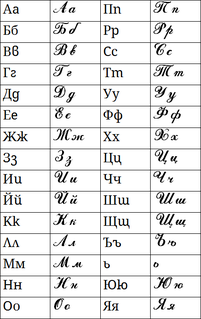Transliteration is a type of conversion of a text from one script to another that involves swapping letters in predictable ways, such as Greek ⟨α⟩ → ⟨a⟩, Cyrillic ⟨д⟩ → ⟨d⟩, Greek ⟨χ⟩ → the digraph ⟨ch⟩, Armenian ⟨ն⟩ → ⟨n⟩ or Latin ⟨æ⟩ → ⟨ae⟩.
A breve is the diacritic mark ˘, shaped like the bottom half of a circle. As used in Ancient Greek, it is also called brachy, βραχύ. It resembles the caron but is rounded, in contrast to the angular tip of the caron.

Romanization or romanisation, in linguistics, is the conversion of writing from a different writing system to the Roman (Latin) script, or a system for doing so. Methods of romanization include transliteration, for representing written text, and transcription, for representing the spoken word, and combinations of both. Transcription methods can be subdivided into phonemic transcription, which records the phonemes or units of semantic meaning in speech, and more strict phonetic transcription, which records speech sounds with precision.
Devanāgarī is an Indian script used for languages including Hindi, Marathi, Nepali and Sanskrit. There are several somewhat similar methods of transliteration from Devanāgarī to the Roman script, including the influential and lossless IAST notation.

Cyrillization or Cyrillisation is the process of rendering words of a language that normally uses a writing system other than Cyrillic script into the Cyrillic alphabet. Although such a process has often been carried out in an ad hoc fashion, the term "cyrillization" usually refers to a consistent system applied, for example, to transcribe names of German, Chinese, or English people and places for use in Russian, Ukrainian, Serbian, Macedonian or Bulgarian newspapers and books. Cyrillization is analogous to romanization, when words from a non-Latin-script-using language are rendered in the Latin alphabet for use
Polivanov system is a system of transliterating the Japanese language into Russian Cyrillic script, either to represent Japanese proper names or terms in Russian or as an aid to Japanese language learning in those languages. The system was developed by Yevgeny Polivanov in 1917.

Wylie transliteration is a method for transliterating Tibetan script using only the letters available on a typical English-language typewriter. The system is named for the American scholar Turrell V. Wylie, who created the system and described it in a 1959 paper published in the Harvard Journal of Asiatic Studies. It has subsequently become a standard transliteration scheme in Tibetan studies, especially in the United States.

The Bulgarian alphabet is used to write the Bulgarian language.

Romanization of Russian is the process of transliterating the Russian language from the Cyrillic script into the Latin script.

Ye, Je, or Ie is a letter of the Cyrillic script. In some languages this letter is called E. It looks like another version of E (Cyrillic).
The romanizationof Ukrainian is the representation of the Ukrainian language using Latin letters. Ukrainian is natively written in its own Ukrainian alphabet, which is based on the Cyrillic script. Romanization may be employed to represent Ukrainian text or pronunciation for non-Ukrainian readers, on computer systems that cannot reproduce Cyrillic characters, or for typists who are not familiar with the Ukrainian keyboard layout. Methods of romanization include transliteration, representing written text, and transcription, representing the spoken word.

Hebrew uses the Hebrew alphabet with optional vowel diacritics. The romanization of Hebrew is the use of the Latin alphabet to transliterate Hebrew words.
Ə ə, also called schwa, is an additional letter of the Latin alphabet. In the International Phonetic Alphabet (IPA), minuscule ə is used to represent the mid central vowel or a schwa. Thus it corresponds to the A sound in America. It is or was used in several languages around the world, including the Azerbaijani, Gottscheerish, Karay·a and Adyghe languages, and Abenaki language of Quebec, and in the hən̓q̓əmin̓əm̓ dialect of Halkomelem. Both the majuscule and minuscule forms of this letter are based on the form of a turned e, while the Pan-Nigerian alphabet pairs the same lowercase letter with Ǝ.
The romanization of Khmer refers to the romanization of the Khmer (Cambodian) language, that is, the representation of that language using letters of the Latin (Roman) alphabet. This is most commonly done with Khmer proper nouns such as names of people and geographical names, as in a gazetteer.
Scientific transliteration, variously called academic, linguistic, international, or scholarly transliteration, is an international system for transliteration of text from the Cyrillic script to the Latin script (romanization). This system is most often seen in linguistics publications on Slavic languages.
The SASM/GNC/SRC romanization of Tibetan, commonly known as Tibetan pinyin or ZWPY, is the official transcription system for the Tibetan language in the People's Republic of China for personal names and place names. It is based on pronunciation of China National Radio's Tibetan Radio pronunciation, which is the Lhasa dialect of Standard Tibetan and reflects the pronunciation except that it does not mark tone. It has been used within China as an alternative to the Wylie transliteration for writing Tibetan in the Latin script since 1982.
Romanisation of Bengali is the representation of written Bengali language in the Latin script. Various romanisation systems for Bengali are used, most of which do not perfectly represent Bengali pronunciation. While different standards for romanisation have been proposed for Bengali, none has been adopted with the same degree of uniformity as Japanese or Sanskrit.
Romanization of Persian or Latinization of Persian is the representation of the Persian language with the Latin script. Several different romanization schemes exist, each with its own set of rules driven by its own set of ideological goals.
The former State Administration of Surveying and Mapping, Geographical Names Committee and former Script Reform Committee of the People's Republic of China have adopted several romanizations for Chinese, Mongolian, Tibetan and Uyghur, officially known as pinyin, Regulation of Phonetic Transcription in Hanyu Pinyin Letters of Place Names in Minority Nationality Languages and Orthography of Chinese Personal Name in Hanyu Pinyin Letters. These systems may be referred to as SASM/GNC/SRC transcriptions or SASM/GNC romanizations.
ISO 11940-2 is an ISO standard for a simplified transcription of the Thai language into Latin characters.






